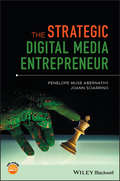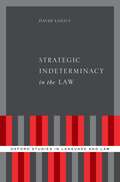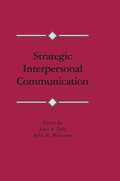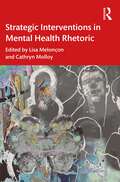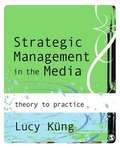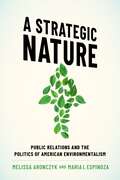- Table View
- List View
Strategic Communication Theory and Practice: The Cocreational Model
by Carl H. BotanA guide to strategic communication that can be applied across a range of subfields at all three levels—grand strategic, strategic, and tactical communication Communication is a core function of every human organization so when you work with communication you are working with the very core of the organization. Written for students, academics, and professionals, Strategic Communication Theory and Practice: The Cocreational Model argues for a single unified field of strategic communication based in the three large core subfields of public relations, marketing communication, and health communication, as well as strategic communicators working in many other subfields such as political communication, issues management, crisis communication, risk communication, environmental and science communication, social movements, counter terrorism communication, public diplomacy, public safety and disaster management, and others. Strategic Communication Theory and Practice is built around a cocreational model that shifts the focus from organizational needs and the messages crafted to achieve them, to a publics-centered view placing publics and their ability to cocreate new meanings squarely in the center of strategic communication theory and practice. The author—a noted expert in the field—outlines the theories, campaign strategies, common issues, and cutting edge challenges facing strategic communication, including the role of social media, ethics, and intercultural strategic communication. As the author explains, the term "strategic communication" properly refers only to the planned campaigns that grow out of research and understanding what publics think and want. This vital resource answers the questions of whether, and how, strategic-level skills can be used across fields, as it: Explores the role of theory and the cocreational meta-theory in strategic communication Outlines ethical practices and problems in the field Includes information on basic campaign strategies Offers the most recent information on risk communication, preparedness and terrorism communication, and employment in strategic communication Redefines major concepts, such as publics, from a cocreational perspective
Strategic Communications in Africa: The Sub-Saharan Context (Routledge New Directions in PR & Communication Research)
by Hugh MangeyaStrategic communication is a pre-requisite for the achievement of organisational goals and an effective strategic communication plan is vital for organisational success. However, systems and models dominant in the west may not necessarily be best suited for the sub-Saharan Africa reality, where many organisations lack adequate financial resources to develop and implement an effective strategic communication plan. This book examines current practices in sub-Saharan Africa, as well as the challenges faced and the intersection with culture. The Editors package inspiring debates, experiences and insights relating to strategic communication in all types of institutions, including private and public sector organisations, governmental organisations and NGOs, political parties as well as social movements in the sub-Saharan context. It explores how culture is integral to the attainment of strategic communication goals, and diverse case studies across socio-economic contexts offer insights into the successes of organisations across Africa, including Zimbabwe, South Africa, Tanzania, Lesotho, Zambia, and Nigeria. This unique edited collection is a valuable resource for worldwide scholars, researchers and students of strategic communication and organisational studies, as well as related fields including public relations, advertising, political and health communication, and international studies.
Strategic Communications in Africa: The Sub-Saharan Context (Routledge New Directions in PR & Communication Research)
by Hugh Mangeya Isaac Mhute Ernest JakazaStrategic communication is a pre-requisite for the achievement of organisational goals and an effective strategic communication plan is vital for organisational success. However, systems and models dominant in the west may not necessarily be best suited for the sub-Saharan Africa reality, where many organisations lack adequate financial resources to develop and implement an effective strategic communication plan. This book examines current practices in sub-Saharan Africa, as well as the challenges faced and the intersection with culture. The Editors package inspiring debates, experiences and insights relating to strategic communication in all types of institutions, including private and public sector organisations, governmental organisations and NGOs, political parties as well as social movements in the sub-Saharan context. It explores how culture is integral to the attainment of strategic communication goals, and diverse case studies across socio-economic contexts offer insights into the successes of organisations across Africa, including Zimbabwe, South Africa, Tanzania, Lesotho, Zambia, and Nigeria. This unique edited collection is a valuable resource for worldwide scholars, researchers and students of strategic communication and organisational studies, as well as related fields including public relations, advertising, political and health communication, and international studies.
Strategic Conflict
by Daniel J. Canary Sandra LakeyStrategic Conflict offers a research-based, accessible analysis of how people can manage conflict productively. Moving beyond the basics of conflict, it examines interpersonal situations in which conflict occurs and promotes strategic communicative responses based on the latest theoretical research. Daniel J. Canary and his colleagues add personal observations, media examples, and samples of actual interaction to provide concrete illustrations of the research findings. This comprehensive volume provides students with the tools to understand conflict in real-world contexts. ?
Strategic Conflict
by Daniel J. Canary Sandra LakeyStrategic Conflict offers a research-based, accessible analysis of how people can manage conflict productively. Moving beyond the basics of conflict, it examines interpersonal situations in which conflict occurs and promotes strategic communicative responses based on the latest theoretical research. Daniel J. Canary and his colleagues add personal observations, media examples, and samples of actual interaction to provide concrete illustrations of the research findings. This comprehensive volume provides students with the tools to understand conflict in real-world contexts. ?
The Strategic Digital Media Entrepreneur
by Penelope M. Abernathy JoAnn SciarrinoA goldmine of strategic insights and practical business guidance covering all aspects of media entrepreneurship in the Digital Age The media industry is facing epic upheaval. Revolutionary new technologies compel those in businesses as diverse as broadcasting to book publishing to radically recreate their business models or be left in history’s wake. At the same time, those with the next big idea are eager to acquire the business know-how needed to make it in today’s brave new world of media. Written by a uniquely well-qualified author team, this book addresses the concerns of both audiences. Penelope Muse Abernathy and JoAnn Sciarrino provide timely lessons on everything from media financing to marketing, business strategy to leadership, innovation to business accounting. They use numerous case studies and real-world vignettes to reveal the success secrets of today’s hottest media entrepreneurs, as well as the fatal flaws that leads many promising new ventures down the road to ruin. They begin with a primer on digital entrepreneurship basics, covering how to create a winning digital business model, obtain financing, do business accounting, identify strategic challenges, and more. From there they show you how to: Develop sustainable customer-focused strategies while overcoming the unique leadership challenges of the Digital Age Define your company’s unique value proposition, prioritize investments in key assets, and form strategic partnerships and alliances Understand and prepare to exploit the vast potential inherent in the next generation of digital technologies, including artificial intelligence, virtual reality, and blockchain, among others The two companion websites feature a wealth of supplemental material, including updates, instructional videos, essays by media leaders, as well as PowerPoint presentations and study guides for instructors. Packed with practical insights and guidance on all aspects of the business of media in the Digital Age, The Strategic Digital Media Entrepreneur is a must-have resource for professionals and students alike in advertising, marketing, business strategy, entrepreneurship, finance, social media, and more.
Strategic Indeterminacy in the Law (Oxford Studies in Language and Law)
by David LaniusThough indeterminacy in legal texts is pervasive, there is a widespread misunderstanding about what indeterminacy is, particularly as it pertains to law. Legal texts present unique challenges insofar as they address a heterogeneous audience, are applied in a variety of unforeseeable circumstances and must, at the same time, lay down clear and unambiguous standards. Sometimes they fail to do so, however, either by accident or by intention. While many have claimed that indeterminacy facilitates flexibility and can be strategically used, few have recognized that there are more forms of indeterminacy than vagueness and ambiguity. A comprehensive account of legal indeterminacy is thus called for. David Lanius here answers that call and in so doing, addresses three central questions about the role of indeterminacy in the law. First, what are the sources of indeterminacy in law? Second, what effects do the different forms of indeterminacy have? Third, how can and should these forms be intentionally used? Based on a thorough examination of the advantages and disadvantages of the different forms of indeterminacy in the wording of laws, contracts, and verdicts, Lanius argues for the claim that semantic vagueness is less relevant than commonly supposed in the debate, while other forms of indeterminacy (in particular, polysemy and standard-relativity) are mistakenly underrated or even ignored. This misconception is due to a systematic confusion between semantic vagueness and these other forms of indeterminacy. Once it is resolved, the value and functions of linguistic indeterminacy in the law can be clearly shown.
Strategic Indeterminacy in the Law (Oxford Studies in Language and Law)
by David LaniusThough indeterminacy in legal texts is pervasive, there is a widespread misunderstanding about what indeterminacy is, particularly as it pertains to law. Legal texts present unique challenges insofar as they address a heterogeneous audience, are applied in a variety of unforeseeable circumstances and must, at the same time, lay down clear and unambiguous standards. Sometimes they fail to do so, however, either by accident or by intention. While many have claimed that indeterminacy facilitates flexibility and can be strategically used, few have recognized that there are more forms of indeterminacy than vagueness and ambiguity. A comprehensive account of legal indeterminacy is thus called for. David Lanius here answers that call and in so doing, addresses three central questions about the role of indeterminacy in the law. First, what are the sources of indeterminacy in law? Second, what effects do the different forms of indeterminacy have? Third, how can and should these forms be intentionally used? Based on a thorough examination of the advantages and disadvantages of the different forms of indeterminacy in the wording of laws, contracts, and verdicts, Lanius argues for the claim that semantic vagueness is less relevant than commonly supposed in the debate, while other forms of indeterminacy (in particular, polysemy and standard-relativity) are mistakenly underrated or even ignored. This misconception is due to a systematic confusion between semantic vagueness and these other forms of indeterminacy. Once it is resolved, the value and functions of linguistic indeterminacy in the law can be clearly shown.
Strategic Interpersonal Communication (Routledge Communication Series)
by John A. Daly John M. WiemannThis book discusses how people go about achieving their social goals through human symbolic interaction. The editors' collective presumption is that there are more or less typical ways that people attempt to obtain desired outcomes -- be they persuasive, informative, conflictive, or the like -- through communication. Representing a first summary of research done by scholars, primarily in the communication discipline, this volume seeks to identify and understand how it is that people achieve what they want through social interaction. Under the very broad label of strategies, this research has sought to: * identify critical social goals such as gaining compliance, generating affinity, resolving social conflict, and offering information; * specify, for each goal, the ways, or strategies, by which people can go about achieving these goals; * determine predictors of strategy selection -- that is, why does a person opt for one strategy over others to obtain the desired end? The research also reflects the attention the field of communication has given to strategy issues in the past 15 years. The chapters describe research on the ways in which people achieve different goals, and summarize existing research and theory on the attainment of social goals. Readers will gain insight into many of the issues that exist regardless of the strategy being discussed. Thus, this volume may not include chapters on topics such as ways people elicit or offer disclosure, ways people demonstrate anger, or ways people create guilt, but the issues that appear consistently throughout the various chapters should apply equally to these. Finally, the essays in this volume provide not only a summary of what has been accomplished to date, but also an initial theoretic map for future research concerning strategic interpersonal communication.
Strategic Interpersonal Communication (Routledge Communication Series)
by John A. Daly John M. WiemannThis book discusses how people go about achieving their social goals through human symbolic interaction. The editors' collective presumption is that there are more or less typical ways that people attempt to obtain desired outcomes -- be they persuasive, informative, conflictive, or the like -- through communication. Representing a first summary of research done by scholars, primarily in the communication discipline, this volume seeks to identify and understand how it is that people achieve what they want through social interaction. Under the very broad label of strategies, this research has sought to: * identify critical social goals such as gaining compliance, generating affinity, resolving social conflict, and offering information; * specify, for each goal, the ways, or strategies, by which people can go about achieving these goals; * determine predictors of strategy selection -- that is, why does a person opt for one strategy over others to obtain the desired end? The research also reflects the attention the field of communication has given to strategy issues in the past 15 years. The chapters describe research on the ways in which people achieve different goals, and summarize existing research and theory on the attainment of social goals. Readers will gain insight into many of the issues that exist regardless of the strategy being discussed. Thus, this volume may not include chapters on topics such as ways people elicit or offer disclosure, ways people demonstrate anger, or ways people create guilt, but the issues that appear consistently throughout the various chapters should apply equally to these. Finally, the essays in this volume provide not only a summary of what has been accomplished to date, but also an initial theoretic map for future research concerning strategic interpersonal communication.
Strategic Interventions in Mental Health Rhetoric
by Lisa MelonçonOffering rhetorically informed strategic interventions, this innovative collection moves beyond critiques of mental health issues, problems, and care. With sections that focus on methodological, cultural and legal, and pedagogical interventions, readers will find an engaging discussion of a discrete mental health phenomenon as well as a clear interventional takeaway in each chapter. Contributors make use of critical discourse analyses, ethnographic inquiries, autoethnographic inquiries, case studies, and textual analyses to engage such mental health research topics as postpartum depression among Chinese mothers; insanity pleas; anosognosia; issues of intimacy, access, and embodiment in research projects; community support groups; Black mental health; women in Alcoholics Anonymous; and mental health in faculty workshops and university online health tools. The authors and editors create scholarship on mental health that explicitly builds productive methodological, theoretical, and practical bridges among scholars and teachers in the various specialties of writing and communication. This collection will interest scholars, students, and practitioners in health and medical humanities; rhetoric of health and medicine; health communication; medical anthropology; scientific and technical communication; disability studies; and rhetorical studies generally.
Strategic Interventions in Mental Health Rhetoric
by Lisa Melonçon Cathryn MolloyOffering rhetorically informed strategic interventions, this innovative collection moves beyond critiques of mental health issues, problems, and care. With sections that focus on methodological, cultural and legal, and pedagogical interventions, readers will find an engaging discussion of a discrete mental health phenomenon as well as a clear interventional takeaway in each chapter. Contributors make use of critical discourse analyses, ethnographic inquiries, autoethnographic inquiries, case studies, and textual analyses to engage such mental health research topics as postpartum depression among Chinese mothers; insanity pleas; anosognosia; issues of intimacy, access, and embodiment in research projects; community support groups; Black mental health; women in Alcoholics Anonymous; and mental health in faculty workshops and university online health tools. The authors and editors create scholarship on mental health that explicitly builds productive methodological, theoretical, and practical bridges among scholars and teachers in the various specialties of writing and communication. This collection will interest scholars, students, and practitioners in health and medical humanities; rhetoric of health and medicine; health communication; medical anthropology; scientific and technical communication; disability studies; and rhetorical studies generally.
Strategic Management in the Media: Theory to Practice (PDF)
by Lucy Küng"This book provides vital insights into the elements of strategy and their application to media firms. Solidly grounded in theory but not pedantic, it is essential reading for those who make or wish to comprehend choices of media companies." - Robert Picard, University of Jönköping "Insightful, contextually analytical, yet easy to comprehend, Strategic Management in the Media successfully applies the adaptive and interpretative areas of strategic theory in the media sectors. It provides a unique perspective in which common themes linking media strategy and industry environment are thoughtfully discussed." - Sylvia M. Chan-Olmsted, University of Florida "...an invaluable asset for students of media management. The use of pertinent examples and case studies throughout brings the analysis to life and contributes to a highly readable introduction." - Gillian Doyle, University of Glasgow This book is a comprehensive, accessible and expert introduction to strategy within a media management context. It is divided into two parts - part one providess an introduction to and overview of the media industry from a strategic management perspective, looking in detail at the sectors that together comprise the industry - newspaper, book and magazine publishing, music, radio and television - and the strategic forces at work in each. This provides the foundation for part two, which analyses a number of strategic topics central to the media sector, such as technological change, organisational structure, leadership, and creativity and innovation. The chapters follow the same structure: the relevant theory is outlined, its application to the media industry is discussed, and case studies from the media industry are used to illustrate the theory and illuminate its relevance for the media field. The cases and examples used come from all sectors of the industry and a range of geographic regions and include News Corporation, Endemol, BBC, Bertelsmann, CNN, MTV, Disney and Pixar.
Strategic Management in the Media: Theory to Practice
by Lucy Küng"This book provides vital insights into the elements of strategy and their application to media firms. Solidly grounded in theory but not pedantic, it is essential reading for those who make or wish to comprehend choices of media companies." - Robert Picard, University of Jönköping "Insightful, contextually analytical, yet easy to comprehend, Strategic Management in the Media successfully applies the adaptive and interpretative areas of strategic theory in the media sectors. It provides a unique perspective in which common themes linking media strategy and industry environment are thoughtfully discussed." - Sylvia M. Chan-Olmsted, University of Florida "...an invaluable asset for students of media management. The use of pertinent examples and case studies throughout brings the analysis to life and contributes to a highly readable introduction." - Gillian Doyle, University of Glasgow This book is a comprehensive, accessible and expert introduction to strategy within a media management context. It is divided into two parts - part one providess an introduction to and overview of the media industry from a strategic management perspective, looking in detail at the sectors that together comprise the industry - newspaper, book and magazine publishing, music, radio and television - and the strategic forces at work in each. This provides the foundation for part two, which analyses a number of strategic topics central to the media sector, such as technological change, organisational structure, leadership, and creativity and innovation. The chapters follow the same structure: the relevant theory is outlined, its application to the media industry is discussed, and case studies from the media industry are used to illustrate the theory and illuminate its relevance for the media field. The cases and examples used come from all sectors of the industry and a range of geographic regions and include News Corporation, Endemol, BBC, Bertelsmann, CNN, MTV, Disney and Pixar.
Strategic Management in the Media Industry: Theory and Practice (PDF)
by Lucy Kung-ShanklemanThis book is a comprehensive, accessible and expert introduction to strategy within a media management context.
The Strategic Marketing of Science, Technology, and Medical Journals: A Business History of a Dynamic Marketplace, 2000–2020
by Albert N. GrecoThis book analyzes the various economic and marketing strategies utilized by the five major STM commercial scholarly journal publishers since 2000. This period has witnessed tremendous economic, marketing, and technological growth including the migration from a print only to a hybrid publishing format. With this growth, the industry has also seen the rise of open access publishing, copyright challenges by websites such as Sci-Hub, the emergence of sharing platforms such as ResearchGate and Academia.edu, as well as the impact of Plan S on publishers, universities, and authors. Given this incredible rate of change across the industry, the author explores the diverse strategies and structures created by the largest STm publishers to decipher their effectiveness in addressing technological, ethical, and copyright issues. Also, he examines how mergers and acquisitions diversified operations, such Elsevier's acquisition of Bepress, SSRN, and SCOPUS, among other platforms. Scrutinizing the different managerial, marketing, technology, and economic-financial strategies crafted by scholarly journal publishers between 2000-2020, this book offers a comprehensive assessment of the industry's attempts to identify, understand, cope with, and minimize or defeat the herculean threats to its business model.
A Strategic Nature: Public Relations and the Politics of American Environmentalism
by Melissa Aronczyk Maria I. EspinozaA look at how public relations has dominated public understanding of the natural environment for over one hundred years. In A Strategic Nature, Melissa Aronczyk and Maria I. Espinoza examine public relations as a social and political force that shapes both our understanding of the environmental crises we now face and our responses to them. Drawing on in-depth interviews, ethnography, and archival research, Aronczyk and Espinoza document the evolution of PR techniques to control public perception of the environment since the beginning of the twentieth century. More than spin or misinformation, PR affects how institutions and individuals conceptualize environmental problems -- from conservation to coal mining to carbon credits. Revealing the linkages of professional strategists, information politics, and environmental standards, A Strategic Nature shows how public relations restricts alternative paths to a sustainable climate future.
A Strategic Nature: Public Relations and the Politics of American Environmentalism
by Melissa Aronczyk Maria I. EspinozaA look at how public relations has dominated public understanding of the natural environment for over one hundred years. In A Strategic Nature, Melissa Aronczyk and Maria I. Espinoza examine public relations as a social and political force that shapes both our understanding of the environmental crises we now face and our responses to them. Drawing on in-depth interviews, ethnography, and archival research, Aronczyk and Espinoza document the evolution of PR techniques to control public perception of the environment since the beginning of the twentieth century. More than spin or misinformation, PR affects how institutions and individuals conceptualize environmental problems -- from conservation to coal mining to carbon credits. Revealing the linkages of professional strategists, information politics, and environmental standards, A Strategic Nature shows how public relations restricts alternative paths to a sustainable climate future.
Strategic Organizational Communication: In a Global Economy
by Charles Conrad Marshall Scott PooleSurveying a wide variety of disciplines, this fully-revised 7th edition offers a sophisticated and engaging treatment of the rapidly expanding field of organizational communication Places organizations and organizational communication within a broader social, economic, and cultural context Applies a global perspective throughout, including thoughtful consideration of non-Western forms of leadership, as well as global economic contexts Offers a level of sophistication and integration of ideas from a variety of disciplines that makes this treatment definitive Updated in the seventh edition: Coverage of recent events and their ethical dimensions, including the bank crisis and bailouts in the US and UK Offers a nuanced, in-depth discussion of technology, and a new chapter on organizational change Includes new and revised case studies for a fresh view on perennial topics, incorporating a global focus throughout Online Instructors' Manual, including sample syllabi, tips for using the case studies, test questions, and supplemental case studies
Strategic Organizational Communication: In a Global Economy
by Charles Conrad Marshall Scott PooleSurveying a wide variety of disciplines, this fully-revised 7th edition offers a sophisticated and engaging treatment of the rapidly expanding field of organizational communication Places organizations and organizational communication within a broader social, economic, and cultural context Applies a global perspective throughout, including thoughtful consideration of non-Western forms of leadership, as well as global economic contexts Offers a level of sophistication and integration of ideas from a variety of disciplines that makes this treatment definitive Updated in the seventh edition: Coverage of recent events and their ethical dimensions, including the bank crisis and bailouts in the US and UK Offers a nuanced, in-depth discussion of technology, and a new chapter on organizational change Includes new and revised case studies for a fresh view on perennial topics, incorporating a global focus throughout Online Instructors' Manual, including sample syllabi, tips for using the case studies, test questions, and supplemental case studies
Strategic Planning for Public Relations
by Deborah A. Silverman Ronald D. SmithThe seventh edition of Strategic Planning for Public Relations maintains its status as a leading text to guide students in developing successful public relations campaigns.Deborah Silverman and Ronald Smith bring their experience as instructors and public relations professionals to the book, providing clear, step-by-step guidance on how to plan and implement strategic communications campaigns. This new edition includes diverse examples of current cases along with classic cases that stand the test of time. It includes new “Ethics Minutes” scenarios in each step, a new research step, and examples of award-winning public relations campaigns. It also significantly increases information on social media and features a reformatting of the tactics step into four separate parts based on the PESO model (paid media, earned media, shared media, and owned media).As a leader in teaching public relations strategy, this text is ideal for students in upper division undergraduate and graduate courses in public relations strategy and campaigns.Complementing the book are online resources for both students and instructors. For students: step overviews, useful links to professional organizations and resources, checklists for the ten steps in the planning process, and two sample campaigns. For instructors: an instructors’ manual, PowerPoint slides, sample syllabi, a critique evaluation worksheet, and checklists for the ten steps in the planning process. For these online resources, please visit www.routledge.com/9781032391168 .
Strategic Planning for Public Relations
by Deborah A. Silverman Ronald D. SmithThe seventh edition of Strategic Planning for Public Relations maintains its status as a leading text to guide students in developing successful public relations campaigns.Deborah Silverman and Ronald Smith bring their experience as instructors and public relations professionals to the book, providing clear, step-by-step guidance on how to plan and implement strategic communications campaigns. This new edition includes diverse examples of current cases along with classic cases that stand the test of time. It includes new “Ethics Minutes” scenarios in each step, a new research step, and examples of award-winning public relations campaigns. It also significantly increases information on social media and features a reformatting of the tactics step into four separate parts based on the PESO model (paid media, earned media, shared media, and owned media).As a leader in teaching public relations strategy, this text is ideal for students in upper division undergraduate and graduate courses in public relations strategy and campaigns.Complementing the book are online resources for both students and instructors. For students: step overviews, useful links to professional organizations and resources, checklists for the ten steps in the planning process, and two sample campaigns. For instructors: an instructors’ manual, PowerPoint slides, sample syllabi, a critique evaluation worksheet, and checklists for the ten steps in the planning process. For these online resources, please visit www.routledge.com/9781032391168 .
Strategic Reputation Management: Towards A Company of Good
by Pekka Aula Saku MantereStrategic Reputation Management examines the ways in which organizations achieve "goodness" through reputation, reputation management and reputation strategies. It presents a contemporary model of strategic reputation management, helping organizations and stakeholders to analyze the business environment as a communicative field of symbols and meanings in which the organization is built or destroyed. Authors Pekka Aula and Saku Mantere introduce the eight generic reputation strategies, through which organizations can organize their stakeholder relationships in various ways. They illustrate their arguments using real-world examples and studies, from the Finnish Ski Association to Philip Morris International.This book serves as required reading in advanced courses covering public relations practice, advanced topics in PR, corporate communication, management, and marketing. Professionals working in PR, business, management and marketing will also find much of interest in this volume.
Strategic Reputation Management: Towards A Company of Good
by Pekka Aula Saku MantereStrategic Reputation Management examines the ways in which organizations achieve "goodness" through reputation, reputation management and reputation strategies. It presents a contemporary model of strategic reputation management, helping organizations and stakeholders to analyze the business environment as a communicative field of symbols and meanings in which the organization is built or destroyed. Authors Pekka Aula and Saku Mantere introduce the eight generic reputation strategies, through which organizations can organize their stakeholder relationships in various ways. They illustrate their arguments using real-world examples and studies, from the Finnish Ski Association to Philip Morris International.This book serves as required reading in advanced courses covering public relations practice, advanced topics in PR, corporate communication, management, and marketing. Professionals working in PR, business, management and marketing will also find much of interest in this volume.
Strategic Silence: Public Relations and Indirect Communication (Routledge New Directions in PR & Communication Research)
by Roumen DimitrovMainstream public relations overvalues noise, sound and voice in public communication. But how can we explain that while practitioners use silence on a daily basis, academics have widely remained quiet on the subject? Why is silence habitually famed as inherently bad and unethical? Silence is neither separate from nor the opposite of communication. The inclusion of silence on a par with speech and non-verbal means is a vital element of any communication strategy; it opens it up for a new, complex and more reflective understanding of strategic silence as indirect communication. Drawing on a number of disciplines that see in silence what public relations academics have not yet, this book reveals forms of silence to inform public relations solutions in practice and theory. How do we manage silence? How can strategic silence increase the capacity of public relations as a change agent? Using a format of multiple short chapters and practice examples, this is the first book that discusses the concept of strategic silence, and its consequences for PR theory and practice. Applying silence to communication cases and issues in global societies, it will be of interest to scholars and researchers in public relations, strategic communications and communication studies.



